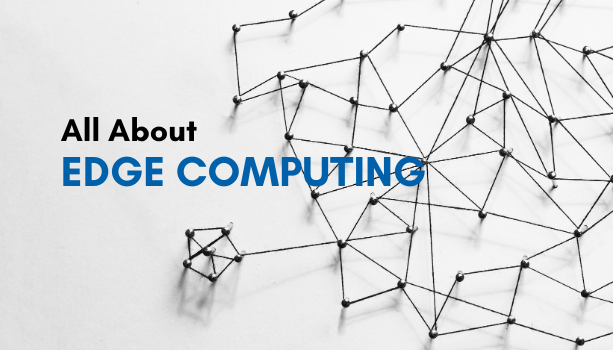What Is Edge Computing? How Is It Different From Cloud Computing and What Does It Take to Secure It?
Cloud Computing: Connecting the Center and the Edge
Most of us are familiar with cloud computing. Public cloud services such as Google Cloud, Microsoft Azure, and Amazon Web Services store and process their users’ data in a centralized data center positioned at the center of the network. Through the Internet, the data center is synchronized with the application interface on the end devices, which lie at the edge of the network.
Since data is stored in a centralized data center — also known as the cloud — users on the edge of the network can access it anytime from any place, making it very convenient for both business and personal use.
The Limitations of Cloud Computing
Synchronization is nothing more than a fancy word for data transfer. In the case of cloud computing, synchronization refers to the process of transferring data from the edge to the center, then back to the edge. This, however, inevitably leads to latency, especially when the volume of data is large.
The good news is that as long as there is decent internet speed, a tiny bit of latency is generally unnoticeable and bearable for most business purposes. Yet, when it comes to using IoT devices or streaming high-quality video content, cloud computing quickly becomes insufficient. Take autonomous vehicles, for example, millions of pieces of information are collected from the road every second by the V2X network, sent back to each vehicle’s computing system, then calculated to determine the next action. No matter how speedy the 5G network is, if all the data had to be sent back and forth from the edge (i.e. the car) to the center (i.e. some data center back at Silicon Valley), latency would be unavoidable. Indeed, a tiny millisecond of delay would determine the life or death of the passengers on board.
These IoT devices have led to the emergence of a new idea — why not move the computing power from the data center to the edge of the network? In other words, instead of sending the collected data all the way back to a centralized data center, why not have local servers process them at the edge of the network to relieve the traffic and minimize the travel distance of data?
What is Edge Computing?
Edge computing is an idea derived from the content delivery network (CDN). A CDN server provides nearby users with cached contents from the central server, reducing latency for users, and relieving the burden of the central server.
Similar to the CDN, edge computing decentralizes the computing infrastructure by distributing the computing resources around the communication path. To put it in perspective, online video streaming services like Netflix use edge computing to process video content locally by saving the cache in an edge server, in a process known as edge caching. The cache would then be transferred to other users who stream the content nearby. This way, the data would not need to be transferred to and from the central data center. Shorter travel distance results in lower latency and faster performance. This explains why the more popular a video is in your region, the faster it is for it to load. In contrast, greater latency would likely be experienced if you were to stream an unpopular 4K video that is not watched by anyone near your location.
Benefits of Edge Computing
Clearly, edge computing allows for faster data transfer, leading to better performance. Because data is being processed and analyzed at the edge nearby the device, the user benefits from enhanced speed with near-zero latency. It also reduces operational costs for the service provider because the total distance traveled by the data is significantly shorter and the volume of the traffic is more evenly spread out, resulting in a lower bandwidth requirement.
Downsides of Edge Computing
The most notable disadvantage of edge computing is that since data is only gathered from smaller networks along the edge, it is more difficult for the service provider to utilize the data for big data analysis. As data is significantly more valuable in aggregate, this is a crucial downside. Hence, under circumstances where latency is not an issue, cloud computing is preferred over edge computing. Today, edge computing tends to be used solely for IoT devices and streaming services, while cloud computing remains the most popular option for traditional IT environments.
How to Secure the Network Edge?
Securing IoT devices is central to the safety of edge computing. Modern IoT devices are much more crucial and complex than our voice assistants and smart refrigerators. Factories, power grids, transportation infrastructure, and of course, connected cars, are all IoT devices that run on edge computing services. Securing these IoT devices would require a two-step approach.
First, all data must be encrypted both when it is in storage and during transit, so that even if an end device gets stolen and broken into, the data would remain safe from unauthorized users. Encryption for edge computing can be done by using VPNs or encryption modules.
With the data encrypted, a robust access and identity management system must be in place to keep unauthorized users from gaining access to the IoT device and compromising sensitive data.
Penta IoT Security is a set of solutions developed by Penta Security to protect IoT devices run on edge computing. Based on sophisticated encryption and authentication technologies, Penta IoT Security offers specialized security solutions dedicated to smart cars (see AutoCrypt), smart homes, smart infrastructure, and smart factories.
Penta IoT Security is a comprehensive answer to the safety concerns over the future of our smart cities, where cars and roads, housing and infrastructure, businesses and consumers are all connected at the edge.
Check out Penta Security’s product lines:
Web Application Firewall: WAPPLES
Database Encryption: D’Amo
Identity and Access Management: ISign+
Car, Energy, Factory, City Solutions: Penta IoT Security
